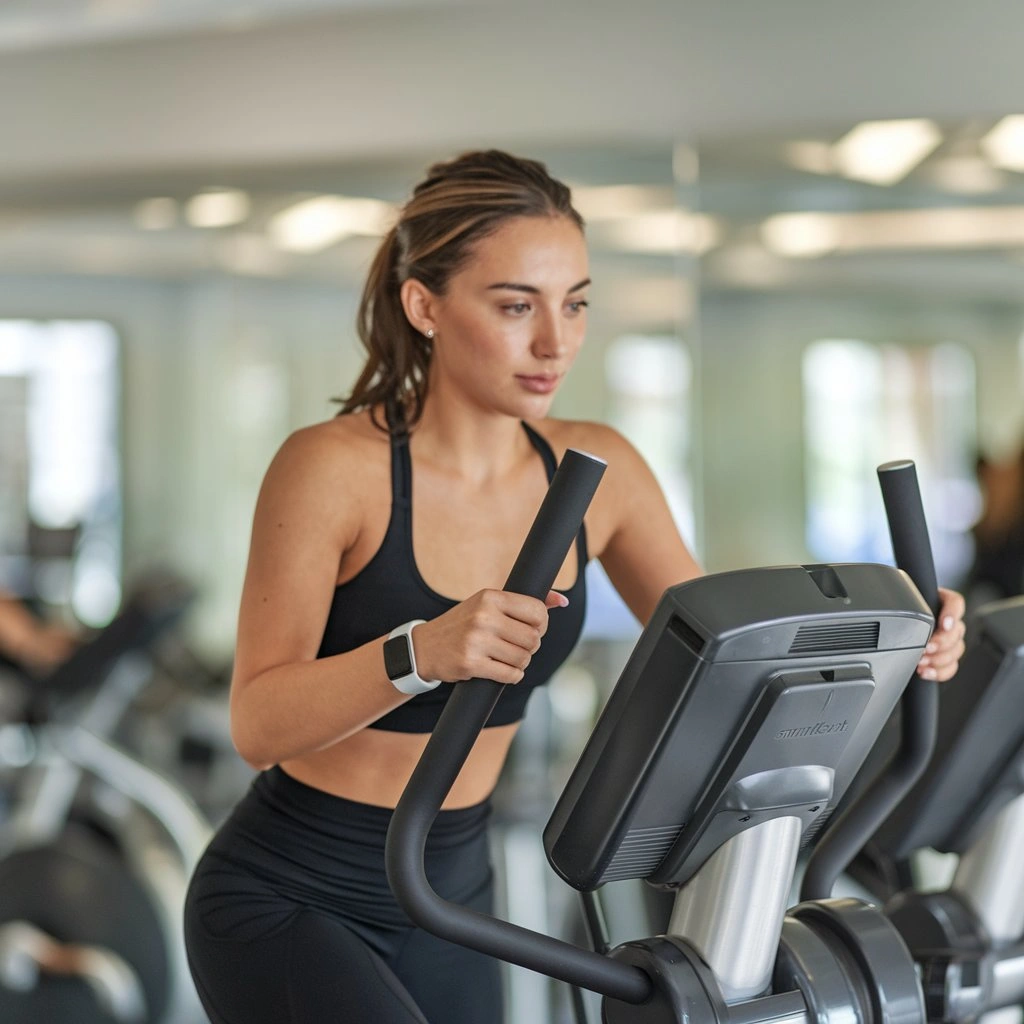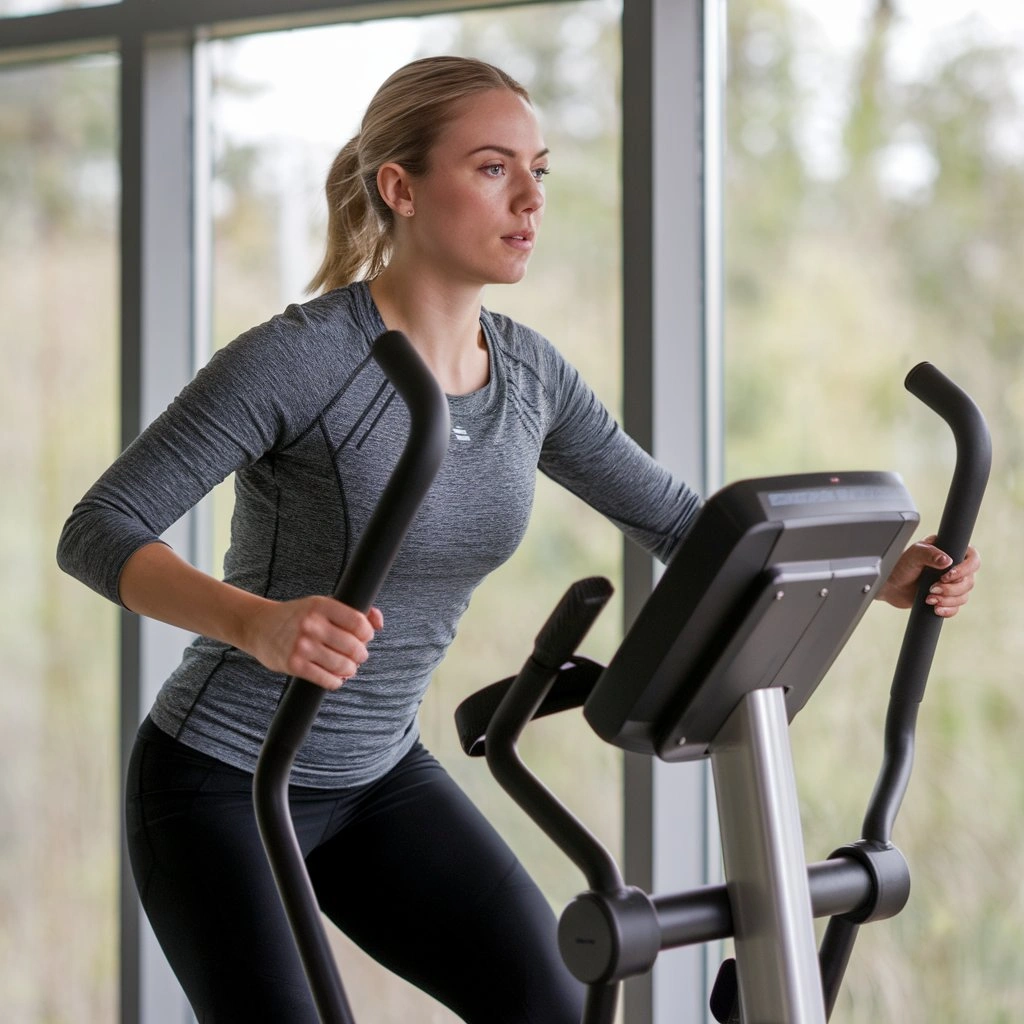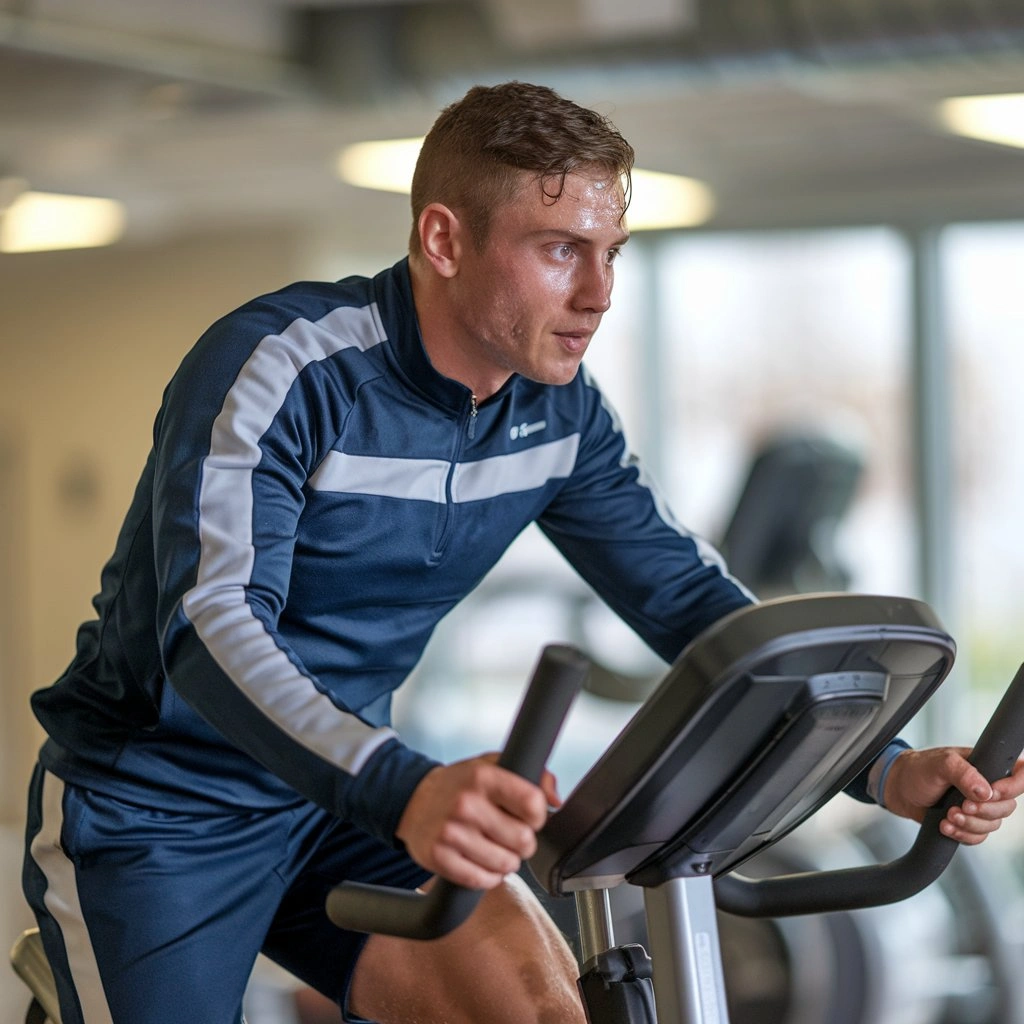Welcome to your elliptical bike workout warm-up routine! The warm-up is crucial. It prepares your body for the workout ahead. It cuts the risk of injury and boosts performance. Here’s how to get started:
- Light Intensity: Start your warm-up by setting the elliptical bike to a low intensity. You should start the workout. This allows your body to adjust and your heart rate to rise.
- Increase your heart rate as you start pedaling. The idea is not to push too hard at first. Instead, you should raise your heart rate. This prepares you for more intense exercise later on.
- Muscle Warm-Up: Pay attention to how your muscles feel as you pedal. You should start feeling them warming up as you continue the exercise. This shows that blood flow is increasing to the muscles. It helps to loosen them up and prepare them for the main part of your workout.
- Proper Form and Posture: During the warm-up, keep proper form and posture. Keep your back straight, shoulders relaxed, and core engaged. Make sure your feet are on the pedals. And, that you’re pedaling and.
- Breathing: Focus on your breathing during the warm-up. Inhale via your nose, then release the air through your mouth. This helps to give oxygen to your Muscles. It readies your breathing for the upcoming workout.
- Duration: Aim to spend 5 to 10 minutes on the warm-up phase. It can vary in length, depending on your fitness and the workout’s intensity. Take note of your body’s needs and change the time.
 Cardiovascular Exercise (20-40 minutes)
Cardiovascular Exercise (20-40 minutes)
Here’s a sample Elliptical Bike workout. It focuses on cardio benefits through moderate to high-intensity intervals.
Warm-up (5 minutes)
- Start with light resistance and a moderate pace. This will warm up your muscles and get your body ready for the workout.
Interval Sets (20-30 minutes)
- High-intensity interval (2 minutes)
- Increase the resistance level or pedal faster. Aim for an intensity that feels hard but sustainable. You should be breathing and feel your heart rate elevate.
- Low-intensity interval (1 minute)
- Lower the resistance or pedal slower. This allows your heart rate to come down and lets you catch your breath.
- Repeat the high-intensity and low-intensity intervals. Do this for 20-30 minutes, depending on your fitness level and time.
- Aim to increase the intensity or resistance level during the workout. This will keep challenging yourself.
Cool-down (5 minutes)
- Finish with a 5-minute cooldown. Lower the resistance and pace. Your heart rate will return to resting levels as a result of this. Use this time to stretch your muscles and promote recovery.
Example
- Warm-up (5 minutes)
- Set the resistance to level 3 and pedal at a moderate pace.
- Interval Sets (20-30 minutes)
- High-intensity interval (2 minutes):
- Increase resistance to level 8 and pedal at a fast pace.
- Low-intensity interval (1 minute)
- Reduce resistance to level 4 and pedal at a slower pace.
- Repeat the high-intensity and low-intensity intervals for a total of 20-30 minutes.
- High-intensity interval (2 minutes):
- Cool-down (5 minutes)
- Reduce resistance to level 1 and pedal at a slow pace for 5 minutes.
- Stretch your leg muscles focusing on quadriceps, hamstrings, calves, and glutes.
Your elliptical bike exercise routine is a form of high-intensity interval training (HIIT). HIIT can improve heart fitness and burn calories. Here’s a breakdown of your routine:
- Warm-Up (2-5 minutes) Start with a light warm-up on the elliptical bike. Pedal at a comfortable pace to raise your heart rate and loosen up your muscles. This is important to prepare your body for the more intense intervals ahead.
- Main Workout (20-30 minutes)
- Pedal at a moderate pace for 5 minutes. You should be able to talk but feel your heart rate rising.
- High Intensity (1 minute): Increase the resistance or speed on the elliptical bike. Push yourself to a challenging level. You should feel like you’re working very hard during this minute.
- Moderate Intensity (2 minutes): After the burst, lower the resistance or speed. This will return you to a moderate pace. This allows you to recover before the next high-intensity interval.
- Continue to alternate. Do 1 minute of high-intensity and 2 minutes of moderate-intensity for your whole workout. Aim to complete 20-30 minutes in total, depending on your fitness level and time available.
- Cool Down (2-5 minutes). Once you’ve finished the high-intensity intervals, reduce your pealing’s intensity. Allow your heart rate to decrease. This helps prevent dizziness and allows your body to transition back to a resting state.
- You don’t have to stretch after your workout. But, if you want to, take a few minutes to stretch key muscle groups. Focus on the legs, hips, and lower back. Stretching helps lessen pain in the muscles and increase flexibility.
Strength Training (10-20 minutes)
Strength training on an elliptical bike can be effective. It builds muscle strength and endurance and provides a full-body workout.
Warm-up (3-5 minutes)
- Start with a light resistance setting and pedal at a moderate pace to warm up your muscles.
- Focus on smooth, controlled movements to prepare your body for the workout ahead.
- Lower Body Exercises (5-7 minutes)
- Increase the resistance setting to challenge your leg muscles.
- Perform intervals of high-resistance pedaling followed by brief periods of recovery. Aim for 1-2 minutes of high intensity followed by 1 minute of lower intensity.
- For your glutes and hamstrings to contract, concentrate on pushing through your heels.
- Add reverse pedaling. It targets different muscles and adds variety to your workout.
- Upper Body Exercises (5-7 minutes)
- Use the movable handles of the elliptical bike to engage your upper body.
- Increase the resistance setting to challenge your arms, shoulders, and chest.
- Use the handles to do intervals of pushing and pulling. Alternate between pushing and pulling for 1-2 minutes each.
- Focus on maintaining proper form and engaging your core for stability.
- Variation: Add single-arm movements or alternating-arm movements to target specific muscle groups.
- Cool Down and Stretching (2-3 minutes)
- Easy lower the resistance. Then, pedal slower to lower your heart rate.
- Do static stretches that target the major muscles used during the workout. This includes the quads, hamstrings, calves, chest, shoulders, and arms.
- Hold each stretch for 15-30 seconds and focus on deep breathing to aid in relaxation and recovery.
Those are excellent suggestions for varying your workout routine on an elliptical bike. Here’s a bit more detail on each:
- Standing or seated climbs: Increase the resistance. Pedal slower to engage more of your leg muscles. Standing climbs can target your glutes, hamstrings, and calves. Seated climbs also work your quads. Ensure proper form to avoid strain on your knees and back.
- Pedaling in reverse targets different muscle groups. These include the calves, shins, and parts of your thighs. It can also help balance muscle development. It works muscles in different ways than forward pedaling.
- Arm movements: Many elliptical bikes come equipped with arm handles or movable arms. Moving your arms engages the muscles in your arms, shoulders, and upper back. It gives a more complete full-body workout. Focus on pushing and pulling with your arms while maintaining proper posture.
 Cool Down (5-10 minutes)
Cool Down (5-10 minutes)
Cooling down after an elliptical bike exercise is key. It lets your body return to its pre-exercise state. It prevents muscle soreness. Here’s a suggested cool-down routine:
- Reduce the resistance and speed of your elliptical machine. Do this over 5-10 minutes. This will help lower your heart rate. It will also transition your body from exercise to rest.
- Stretching: Perform static stretches targeting major muscle groups used during your workout. Hold each stretch for about 15-30 seconds. Don’t bounce. Focus on breathing and relaxing into each stretch. Some stretches you can include are:
- Stretch your quadriceps. Stand and pull one foot towards your glutes. Keep your knees close together.
- Do a Hamstring Stretch. Sit on the floor with one leg out and the other bent. Then, reach for your toes on the outstretched leg.
- Calf Stretch: Lean against a wall with one foot back and the other forward. Keep the back leg straight with the heel on the ground.
- Stretch your hip flexor this way: Kneel on one knee. Then, push your hips forward while keeping your upper body upright.
- Chest Stretch: Clasp your hands behind your back and straighten your arms. This lifts your chest.
- Triceps Stretch: Reach one hand down your back and grab your elbow with the other hand. pull the elbow towards your head.
- Shoulder Stretch: Bring one arm across your body and use the other arm to kind press it towards your chest.
- Lower Back Stretch: Lie on your back and hug your knees towards your chest.
- Deep breathing and relaxation help. Take a few minutes to focus on them. Breathe in low through your nose. Let your abdomen expand. Then, breathe out through your mouth. You can also use mindfulness or meditation techniques. They help relax your body and mind.
Flexibility and Mobility (5-10 minutes)
Sure! Here’s a sample routine for a 5-10-minute flexibility and mobility warm-up. Designed for exercise on an elliptical bike.
- Leg Swings (1 minute each leg): Hold onto a stable surface. Swing one leg forward and backward in a controlled manner to increase the range of motion. Switch to the other leg after a minute.
- Arm Circles (1 minute): Stand tall and extend your arms out to the sides. Rotate your arms in small circles, increasing the size of the circles. After 30 seconds, switch directions.
- Torso Twists (1 minute): Stand with your feet hip-width apart. Put your hands on your hips. Rotate your torso left and then right. Do it in a controlled way. Keep your hips facing forward.
- Hip Circles (1 minute in each direction): Stand upright and circle your hips. Go clockwise for 30 seconds and then counterclockwise for 30 seconds.
- Ankle Circles (1 minute each ankle): Sit on the edge of a chair or bench and extend one leg. Rotate your ankle in a circular motion, first clockwise and then counterclockwise. Repeat with the other ankle.
- Dynamic Quad Stretch (1 minute): Stand on one leg. Pull your other foot towards your butt. You should feel a stretch in the front of your thigh. Release and switch sides, alternating legs for one minute.
- Dynamic Hamstring Stretch (1 minute): Stand tall and take a step forward with one foot. Keeping your back straight, hinge at your hips and reach towards your toes. Return to the starting position and switch legs, alternating for one minute.
- Calf Raises (1 minute): Stand with your feet hip-width apart. Easily raise your heels off the ground, lifting onto the balls of your feet. Lower back down and repeat for one minute.
 Hydration and Nutrition
Hydration and Nutrition
You need to stay hydrated and eat well. These things are key for top performance. You need them during and after using an elliptical bike. Here’s a breakdown of some key points to consider:
Hydration
- Drink water before starting your exercise. This will ensure you’re hydrated. Aim to drink around 16-20 ounces of water about 2 hours before your workout.
- During Exercise: Sip water throughout your workout to maintain hydration levels. The amount of water you should drink depends on how long and hard you exercise. Aim for 7-10 ounces every 10-20 minutes.
- Replenish fluids lost during exercise. Do this by drinking water after your elliptical bike workout. Aim to drink at least 16-24 ounces of water within two hours post-exercise.
Nutrition
- Eat a balanced meal or snack before your workout. It should have carbs and some protein. Eat it 1-2 hours before your workout. This can provide the necessary energy to fuel your exercise session.
- During Exercise: For shorter workouts, you may not need more fuel. But, for longer sessions (more than an hour), consider consuming digestible carbohydrates. Examples are a sports drink or energy gel. They will help you maintain energy.
- Eat a meal or snack with carbs and protein within an hour after your elliptical bike workout. They help recovery and muscle repair. This could include options like a protein shake with fruit. Or a turkey sandwich on whole-grain bread. Or Greek yogurt with berries.
More Tips
- During long exercise or in heat, consider replacing the electrolytes lost through sweat. Do this by having drinks or snacks rich in electrolytes.
- Listen to Your Body. Everyone’s hydration and food needs can vary. Factors such as body size, exercise intensity, and the environment influence this. Pay attention to how your body feels. Adjust your hydration and nutrition as needed.
Progression and Variation
Progress and variation are key. They matter in any exercise, including elliptical bike workouts. Here are some strategies to help you progress. They will also vary your elliptical bike exercise routine:
- Increase Intensity: Slowly raise your workout’s intensity. Do this by adjusting the resistance or incline on the elliptical. You can also go faster or pedal faster. This will challenge your heart and muscles.
- Extend Duration: Social increases the duration of your workouts over time. Start with shorter sessions and easily work your way up to longer durations. This will help improve your endurance and stamina.
- Adjust Resistance: Many elliptical machines offer adjustable resistance settings. Try different resistance levels. They target different muscles and vary workout intensity.
- Use Interval Training. Intervals involve switching between high-intensity exercise and recovery or low-intensity exercise. You can do this by switching between high and low resistance. Or, you can switch between fast and moderate speed.
- Try different programs. Most elliptical machines have built-in workout programs. The programs vary in intensity, duration, and focus. Try different programs, like hill climbs or interval training. This will keep your workouts fun and hard.
- Cross-Training: Add other cardio and strength exercises to your routine. They will complement your elliptical workouts. This could include activities like running, cycling, swimming, or weightlifting. Cross-training helps prevent overuse injuries and keeps your body and mind engaged.
- Use Different Hand Positions. Many elliptical machines have moving handlebars. They allow you to work your upper body. Try different hand positions: overhand, underhand, or neutral grip. They target different muscle groups in your arms, shoulders, and back.
- Track Your Progress: Record your workouts, noting their duration, intensity, and any changes to your routine. This will help you track your progress over time and show areas where you can keep challenging yourself.
- Listen to Your Body. Notice how your body responds to different levels and durations of exercise. It’s important to leave your comfort zone, but you must also listen to your body and rest when needed. This prevents injury and overtraining.
Rest and Recovery
Rest and recovery are key. They are part of any exercise routine, including elliptical bike workouts. Here are some tips to ensure you’re allowing adequate rest and recovery:
Rest Days
Incorporate rest days into your exercise schedule. During these days, your body can recover. It can repair muscles that workouts have stressed. Depending on your fitness level and the intensity of your workouts, aim for 1-2 rest days per week.
Listen to Your Body
Pay attention to how your body feels during and after workouts. If you are tired or sore or have pain beyond typical soreness, it may be a sign that you need more rest. Adjust the intensity or duration of your workouts.
Variety in Workouts
Incorporate variety into your exercise routine. Instead of daily intense elliptical bike workouts, mix in other exercises. These include strength training, yoga, or low-impact activities like walking or swimming. This allows different muscle groups to recover while still staying active.
Sleep
Ensure you’re getting adequate sleep each night. Sleep is crucial for muscle repair and recovery. Aim for 7-9 hours of quality sleep per night to support your fitness goals.
Eat a balanced diet. It will give your body the nutrients it needs for recovery. Eat enough protein. It supports muscle repair. Also, eat carbs. They provide energy.
Hydration
Stay hydrated before, during, and after your workouts. Proper hydration supports recovery and helps prevent muscle cramps and fatigue.
On rest days, do light, low-impact activities. Try stretching, foam rolling, or cycling. These activities promote blood flow and aid in recovery. They do so without stressing your muscles.
Make gradual progress. Avoid increasing the intensity or duration of your workouts too fast. Increase the intensity or duration over time. This allows your body to adapt and reduces the risk of overtraining or injury.

